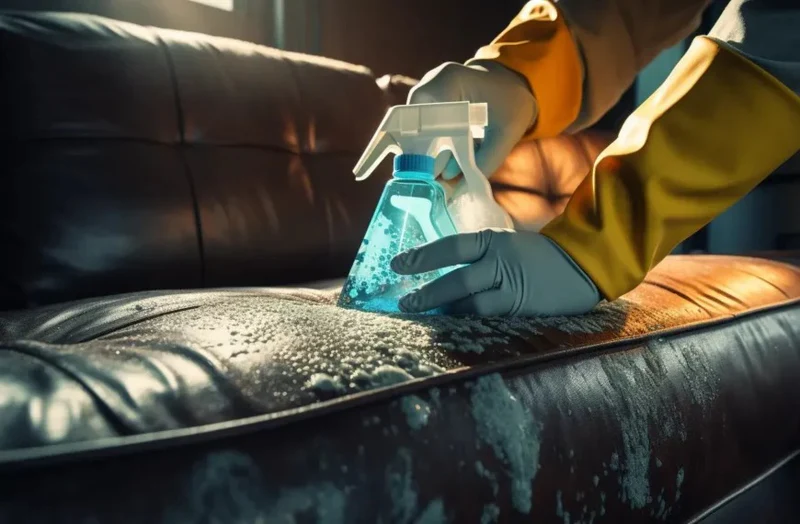Mold on upholstery is a common and frustrating issue, particularly in humid environments or after water damage. Mold spores can not only damage your furniture but also pose significant health risks, including allergic reactions and respiratory issues. Removing mold from upholstered furniture requires care to prevent the spreading of the spores, damage to the fabric, and recurrence of the mold.
In this comprehensive guide, we’ll explore how to safely and effectively get rid of mold from upholstery, using both natural remedies and specialized cleaning products.
Understanding Mold Growth on Upholstery
Mold thrives in damp, warm environments and can grow on a variety of materials, including fabric, foam, and wood, which are often components of upholstered furniture. Whether it’s due to a spill, high humidity, or flooding, mold can quickly spread across upholstery, leading to discoloration, an unpleasant odor, and health risks.
It’s essential to address mold growth as soon as you spot it to prevent further damage and contamination. Left untreated, mold can weaken the fabric and become more challenging to remove.
How to Identify Mold on Upholstery
Mold on upholstery can sometimes be confused with mildew or simple stains, so it’s important to know the signs of mold:
- Visible growth: Mold may appear as black, green, or white spots, particularly in damp or shaded areas of the furniture.
- Musty odor: Mold often produces a distinct, unpleasant musty smell that can be detected before you even see visible signs.
- Health symptoms: If you’re experiencing allergy-like symptoms such as sneezing, coughing, or skin irritation around the affected furniture, mold may be the cause.
Once you’ve identified the presence of mold, it’s time to take action.
Step-by-Step Guide to Removing Mold from Upholstery
1. Safety First: Wear Protective Gear
Before starting the mold removal process, ensure your safety by wearing appropriate protective gear. Mold spores can easily become airborne and cause allergic reactions, so it’s essential to use:
- Gloves: To protect your hands from direct contact with mold.
- Face mask: A mask or respirator to prevent inhaling mold spores.
- Goggles: To protect your eyes from mold spores and cleaning agents.
2. Take the Upholstered Item Outdoors
Whenever possible, take the affected upholstery outdoors to prevent spreading mold spores inside your home. Sunlight can also help kill mold spores, so placing the item in direct sunlight during the cleaning process can be beneficial.
If it’s not possible to move the furniture outdoors, ensure good ventilation in the room by opening windows and using fans to direct airflow out of the space.
3. Vacuum the Affected Area Thoroughly
Start by vacuuming the upholstery to remove loose mold spores and prevent them from spreading further. Use a vacuum cleaner with a HEPA filter (High-Efficiency Particulate Air filter) to trap the spores effectively.
- Attach the brush or upholstery attachment to gently vacuum the moldy area.
- Avoid pressing too hard, as this could push mold deeper into the fabric.
- After vacuuming, dispose of the vacuum bag or empty the canister immediately in a sealed bag to prevent mold spores from escaping back into the air.
4. Prepare a Mold-Cleaning Solution
Once the surface mold has been removed, it’s time to clean the upholstery with a solution that will kill the mold. There are several cleaning options, including natural remedies and commercial mold removers. Choose the method that’s best suited for your type of fabric:
White Vinegar Solution (Natural Remedy)
White vinegar is a natural antifungal agent and is highly effective at killing most types of mold. To make this solution:
- Mix equal parts of white vinegar and water in a spray bottle.
- Lightly spray the solution on the moldy areas, but avoid over-saturating the fabric, as too much moisture can encourage further mold growth.
- Let the solution sit for about 15-20 minutes to penetrate the mold.
Baking Soda and Water Paste
For stubborn mold, you can create a paste using baking soda, which is also a natural deodorizer and mold-killer:
- Mix 3 parts baking soda with 1 part water to form a thick paste.
- Apply the paste to the moldy area with a soft cloth or brush.
- Let it sit for 10-15 minutes before gently scrubbing the upholstery with a soft brush.
Hydrogen Peroxide (For Light-Colored Fabrics)
Hydrogen peroxide is a powerful mold remover but should only be used on light-colored fabrics as it can bleach darker materials.
- Mix 3% hydrogen peroxide with water in a spray bottle.
- Spray lightly on the moldy spots and allow it to sit for 10 minutes before blotting with a clean cloth.
Commercial Mold Cleaners
There are various commercial products designed specifically for removing mold and mildew from fabric and upholstery. These products are ideal for larger or more severe mold infestations.
- Follow the instructions on the product label.
- Always perform a patch test in a hidden area to ensure the cleaner doesn’t damage or discolor the fabric.
5. Gently Scrub the Upholstery
Once you’ve applied your chosen cleaning solution, use a soft brush or a clean cloth to gently scrub the affected area. Be careful not to damage the fabric by scrubbing too hard. For more delicate fabrics, use a soft-bristle brush or sponge.
After scrubbing, use a clean, damp cloth to wipe away the mold and the cleaning solution. You may need to repeat this process until all visible mold is removed.
6. Dry the Upholstery Completely
Mold thrives in moisture, so it’s crucial to dry the upholstery thoroughly after cleaning to prevent the mold from returning. Here’s how to ensure complete drying:
- If outdoors, place the item in direct sunlight for several hours. Sunlight is a natural mold deterrent.
- If indoors, use fans or a dehumidifier to speed up the drying process.
- For smaller items, you can also use a hairdryer on a low setting to dry specific areas.
Avoid using the furniture until it’s completely dry to prevent recontamination with mold.
7. Eliminate Lingering Odors
Even after the mold is gone, a musty odor can sometimes remain. To eliminate this:
- Sprinkle baking soda over the upholstery and let it sit overnight. Vacuum it up the next day.
- Place bowls of activated charcoal or white vinegar near the affected furniture to absorb any remaining odors.
Preventing Mold Growth on Upholstery in the Future
After successfully removing mold from your upholstery, take steps to prevent future mold growth. Mold thrives in warm, damp environments, so it’s important to create conditions that discourage mold formation.
1. Control Humidity Levels
Mold grows rapidly in high-humidity environments, so keep your home’s humidity levels below 60%. Use a dehumidifier in rooms that tend to be humid, such as basements or poorly ventilated living spaces.
2. Improve Air Circulation
Ensure proper air circulation by opening windows, using fans, or installing air vents in areas where moisture is likely to accumulate. Good airflow helps keep the upholstery dry and prevents mold from settling.
3. Dry Spills Immediately
If liquid spills on your upholstered furniture, clean it up immediately and dry the area thoroughly to prevent mold growth. Consider using a fabric protector that resists moisture and stains.
4. Sunlight Exposure
If possible, place your furniture in sunlight for a few hours occasionally. Sunlight naturally kills mold spores and reduces moisture content in upholstery.
5. Regular Cleaning
Routine cleaning and vacuuming will help keep mold and mildew at bay. Pay special attention to cleaning corners, seams, and areas where dirt and moisture can accumulate.
FAQs
1. What kills mold on upholstery fabric?
Ans – White vinegar, baking soda, hydrogen peroxide, and commercial mold removers are all effective at killing mold on upholstery. White vinegar is a natural and safe option for most fabrics, while hydrogen peroxide works well on light-colored fabrics.
2. Is it safe to remove mold from upholstery at home?
Ans – Yes, you can safely remove mold from upholstery at home by following proper cleaning techniques and wearing protective gear like gloves and a mask to avoid inhaling mold spores.
3. How do I prevent mold from growing on my furniture again?
Ans – Prevent mold by controlling humidity, improving air circulation, drying spills immediately, and regularly cleaning your furniture. Using a dehumidifier in damp areas can also help keep mold from growing.
4. Can moldy upholstery be saved?
Ans – In most cases, moldy upholstery can be cleaned and saved if the mold has not deeply penetrated the fabric. However, if the mold growth is extensive or has caused structural damage to the furniture, it may be necessary to replace the upholstery or the furniture.
5. How do I remove musty odors after cleaning mold from upholstery?
Ans – Sprinkle baking soda on the upholstery and let it sit overnight to absorb odors. You can also place bowls of white vinegar or activated charcoal near the furniture to help eliminate any lingering musty smell.
Conclusion
Mold on upholstery is both unsightly and unhealthy, but with the right cleaning techniques and preventive measures, you can successfully get rid of it and restore your furniture. Always prioritize safety by wearing protective gear and using natural or commercial cleaners that are safe for your specific fabric.
By addressing the root cause of mold growth—whether it’s high humidity or moisture—you can prevent future infestations and keep your home clean and healthy.



